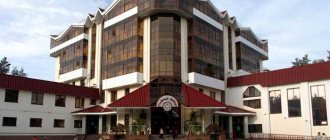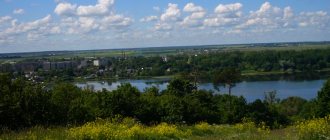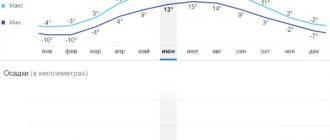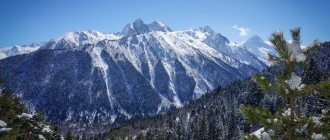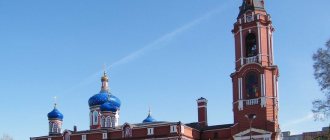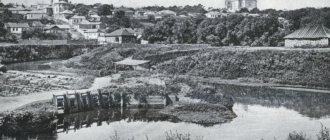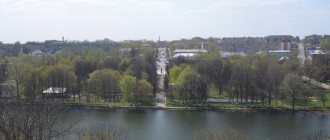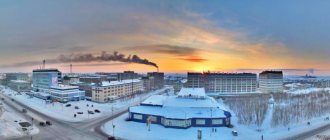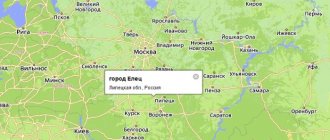Personally, during all the years that we lived in Krasnodar, I greatly underestimated Maikop. We drove past it many times on various trips and I had the idea that Maykop was somehow seedy and uninteresting.
When we took a one-day walk around Maykop, it left only the most pleasant impressions. Now, having become acquainted with the culture and history of this Caucasian people, my opinion about Maykop has changed. In this article I want to share our excursion program, which I developed before my trip to Maykop.
All places mentioned in this article are marked on this map:
How to get from Krasnodar to Maykop
The distance from Krasnodar to Maykop along the highway is 125 kilometers. Buses between cities run regularly throughout the day, approximately every hour, from 4-00 to 20-00. Travel time can be from 1 hour 45 minutes to 3 hours, it depends on the number of intermediate stops the bus makes. Express trains arrive the fastest, as they do not stop anywhere.
From Krasnodar buses depart from the central bus station Krasnodar-1, from Maykop to Krasnodar also from the central bus station, which is located near the railway station.
The distance from the Maykop bus station to the city center is 1.5 km, you can walk, take public transport or taxi. Taxi phone numbers in Maykop: taxi Maxim, taxi Saturn - 8 (918) 356‑63-33, Unified Taxi Service - 8 (8772) 55-77-77.
You can find out about bus routes Krasnodar - Maykop on the Krasnodar bus station website.
And from Maykop to Krasnodar in the afternoon, flights go at: 14-00, 14-30, 14-38, 15-15, 16-15, 17-00, 18-15, 19-10, 20-00. The schedule may change; upon arrival in Maykop, it is better to check it immediately and buy return tickets.
Train Station
The starting point for exploring the city is the Railway Station building, which has become a decoration of the station square since 1910. The main entrance is distinguished by a portico with 4 columns, culminating in pointed arches. The facade facing the square on both sides of the main entrance is built in the form of arched lancet-shaped galleries mounted on rounded columns with capitals. The building was created in the Moorish architectural style and decor.
Interesting facts about Adygea
The Republic of Adygea is the only subject of Russia located inside another subject: the territory of the Republic of Adygea is surrounded on all sides by the territory of the Krasnodar Territory.
From 1937 to 1990, the Adygea Autonomous Region was part of the Krasnodar Territory, and after that it became a separate region with its capital in Maykop. In 1992, the Adygea Autonomous Region was transformed and renamed the Republic of Adygea.
The population of the Republic of Adygea is about 450 thousand people, of which about 145 thousand live in Maykop. The national composition of the inhabitants of the republic is surprising - 70% of the population of Adygea are Russians and only about 20% are Adygeans.
The total number of Adyghe living in Russia is 128 thousand people.
Souvenir in a store window in Maykop
Lagonaki Plateau
It is located between Mount Abadzesh and the Stone Sea ridge. The height of the plateau is about 2000m. Beautiful place. Tourists are delighted by alpine meadows and snow-white peaks, medicinal herbs and aromatic mountain honey.
Things to do:
- go skiing on snowy slopes;
- explore the caves and the Zhelob valley;
- climb Mount Abadzesh;
- explore the surrounding area on a hang glider;
- relax among flowers and herbs.
Vivid impressions await tourists in the mysterious corners of the Caucasus - ancient underground grottoes and stone halls. The most famous place that attracts tourists and speleologists is the Great Azish Cave.
One of the most beautiful caves in Russia. It is located half a kilometer from the Maikop-Lagonaki highway.
Adygs or Adygeis?
There is a fundamental difference between these two concepts. All Adyghe are Adyghe, but not all Adyghe are Adyghe.
Adyghe are a group of peoples speaking Adyghe languages, which includes Adyghe, Kabardians, Circassians and Shapsugs. The number of Circassians is about 3.5 million people. About 720 thousand live in Russia, most of them - almost 500 thousand - live in Kabardino-Balkaria. 1.5 million Circassians live in Turkey, and Circassians also live in Jordan, Iraq, Libya, Syria and other countries.
Adygeis are residents of the Republic of Adygea who have Adyghe nationality.
Monument to Kabardian public figure and poet Shora Nogmov in Maykop
St. Michael's Monastery
Located at the foot of Mount Fiziabgo. There is a unique opportunity to go down into the chapel underground and see the underground cells.
Water from a healing spring fills you with energy.
Address: village, Rodnikovaya st., 5, Pobeda, Republic of Adygea
National language of Adygea
There are 2 official languages in the Republic of Adygea: Russian and Adyghe. In everyday life, Adyghe people speak their national language. When we walked around Maykop, we heard Adyghe speech many times.
Currently, Adyghe writing is carried out in Cyrillic. From 1927 to 1938 they wrote in the Latin alphabet, and until 1927 they used the Arabic alphabet.
When you arrive in Maykop, you can already read the Adyghe name of the city on the building of the bus and railway station - Myekkuape, which translates as “valley of wild apple trees”. Many signs in Maykop and other cities of the republic are duplicated in both languages.
Myekkuape and Maykop - inscriptions on the bus station building
City atmosphere and impressions
Despite the fact that only 20% of Adygeans live in the republic, Adygea is still a representative of Caucasian and Eastern culture.
Here you can see very well-groomed beautiful Muslim women in bright long dresses and headscarves. At the same time, no one looks askance at women dressed more modernly - in trousers or short skirts. There is some kind of gentleness and acceptance in the atmosphere of this city, because Maykop is a multinational city.
On the streets, in cafes and other establishments, we often met friendly and smiling faces. From the Maikop residents we were left with the impression of originality, simplicity and friendly hospitality.
Adyghe carpet in the National Museum of Adygea
What to see in Maykop
Maykop is a relatively young city; it was founded on May 25, 1857 as a military fortification. The main urban development of Maykop was carried out in Soviet times and was done quite systematically. The streets of the city are for the most part strictly perpendicular to each other; the entire center of Maykop consists of identical and even blocks.
In the city center, 5-story buildings from the 60s predominate; there are also a few two-story “Stalin” buildings with high ceilings. There are not so many particularly beautiful old or modern buildings in Maykop, but they still exist in the center. The city has many fountains and greenery; in April, apple trees and other fruit trees bloom everywhere.
View of Maykop from the Ferris wheel in Gorky Park
Friendship Square and Philharmonic Hall
The central square of Maykop is Friendship Square. Mass celebrations and celebrations take place on the square, and it is also a favorite meeting place for young people.
On the approach to Friendship Square you can see a rather remarkable, massive unusual building of the Adyghe Philharmonic Society.
The building of the Adyghe Philharmonic
Until 1968, Friendship Square was called Drovyanaya Square. When the Friendship monument was installed on the square in 1968, a monument symbolizing 400 years of commonwealth with Russia, the square was renamed. This monument is also called “Forever with Russia”, since this is the inscription that can be seen on the monument itself.
Monument "Friendship" on Friendship Square
Cathedral Mosque
On Friendship Square there is also the Cathedral Mosque of the Republic of Adygea, in Adyghe it is written like this: “Gupche Meshchyt”. Adyghe people profess Islam, most of them are Sunni Muslims. Therefore, it is quite natural to see a mosque in the central square of this city.
The cathedral mosque was opened in 2000. It was built as a gift to the Adyghe people from “His Majesty Sheikh Khalid Bin Saqr al-Qassimi, Crown Prince of the Principality of Ras al-Khaimah of the United Arab Emirates.”
The Cathedral Mosque is one of the most beautiful buildings in Maykop. This white beauty with 4 slender minarets and a bright blue dome has become the calling card of the city; its image can be seen on Maykop souvenirs and magnets.
The architecture of the mosque is strict and modern; the interior decoration is also dominated by right angles and straight lines. Inside the mosque, the atmosphere is solemn and strict. Tourists are allowed to visit the mosque, but must remain silent and remove their shoes upon entry.
Cathedral Mosque in Maykop
Prayer hall of the cathedral mosque
Monument of Memory and Unity or “Hearth”
Behind the cathedral mosque there is a monument of Memory and Unity or, as it is popularly called, “The Hearth”. The monument was erected in 2013; it has become an important component in the architectural composition that unites the mosque, the Philharmonic, the Friendship Monument and the National Museum of Adygea.
“Hearth” is dedicated to the memory of the victims of the Caucasian War and is a symbol of the unification of all residents of the republic.
This monument is called a hearth because it is based on the image of a hearth - one of the most expressive elements of Adyghe culture.
Many folk rituals are associated with the hearth. The hearth symbolizes hospitality, abundance and peace. The fire of the Caucasian War extinguished thousands of fires.
Monument Hearth
Museums of Maykop: Art gallery, Museum of the East, National Museum of Adygea
In the center of Maykop, near Friendship Square, there are 3 notable museums: the National Museum of Adygea, the North Caucasus branch of the State Museum of Oriental Art and the Art Gallery of the Republic of Adygea.
The Maykop Art Gallery presents works of sculpture, painting and graphics by contemporary artists of Adygea. The cost of visiting the gallery is 50 rubles.
In the Museum of the East you can see works of art of the peoples of the North Caucasus from antiquity to the present day. Exhibited here are samples of the jewelry art of the peoples of the North Caucasus, a collection of works of art of weaving mats, gold embroidery, patterned felt products of the Balkars and Karachais, a collection of ceramics, wood and metal by Ossetian, Circassian and Dagestan folk craftsmen. The entrance ticket to the Oriental Museum for adults is 100 rubles, children under 16 years old are free.
Building of the National Museum of Adygea
The National Museum introduces the nature of Adygea throughout its entire length from hundreds of millions of years ago to the present day, the culture of the Adyghe people, as well as the more ancient history of the Adyghe land and the people who inhabited it thousands and tens of thousands of years ago.
The National Museum consists of several halls with permanent exhibitions, and there are also temporary exhibitions.
During our visit, we were offered a choice of the following exhibitions: landscapes of Adygea, the geological history of the North-West Caucasus, the culture and life of the Circassians of the late 18th - early 19th centuries, the North-Western Caucasus in the Bronze Age, Adygea during the Great Patriotic War. Tickets were sold for each hall separately, that is, you could choose what to see and pay only for the desired exhibition. The cost of visiting one hall is 30-50 rubles per person.
Stuffed bird of prey in the exhibition landscapes of Adygea
We were impressed by the geological exhibition, where we could see mammoth bones found on the shore of the Krasnodar reservoir, mastodon jaws, giant fossilized mollusks, etc. All these finds are tens of thousands of years old.
Places for walking
Central Park
Address: Pushkin street. Transport stop "City Park" Phone: Website: https://www.parkmp.ru Opening hours: 9:00 - 22:00 (Mon - Sun) Cost: free
Central Park was founded in 1866. I. I. Bratukhin, who later became the mayor of the city, received 50 rubles from the treasury for landscaping the garden. New trees were planted, a pavilion for selling mineral water, a wooden rotunda, and the Pushkin People's House were built. It was because of this building that the park began to be called Pushkinsky. In 1941 it was renamed M. Gorky Park.
In 2009, reconstruction was carried out: new flower beds were planted, alleys and benches appeared. The “Clock” fountain was equipped with a color and music installation. The park has attractions, sports grounds, an open-air swimming pool, the Kino City entertainment complex, an ice arena, and a funicular.
Kurgan Oshad
Address: intersection of Podgornaya and Kurgannaya streets. Ost. "Street of Veterans"
The Oshad Kurgan (Maikop Kurgan) is a monument of the Bronze Age. Its age is more than 5 thousand years. During excavations in 1897, the burial of the leader of the sun worshipers was found here (dated to the 3rd millennium BC). The gold jewelry found here is now kept in the Hermitage.
The name "Oshad" is associated with an Adyghe legend. Not far from Maykop lived five brothers (Arym, Kolyasizhi, Chenshaushkho, Chimdezh and Oshad) and a beautiful sister Susao. One day Susao was kidnapped by the knight Kuzhob. During the chase, 4 brothers died, leaving only Chimdezh.
He overtook the kidnapper and killed him, freeing his sister. However, Chimdezh himself was mortally wounded. At the site of the death of each of the brothers, mounds were erected, which were named in their honor. The Maykop mound, according to legend, is located at the site of Oshad’s death.
At the beginning of the 20th century, the Oshad mound ceased to exist, and in 1972 a white stone stele with a memorial inscription about the mound was installed on this site.
Thermal springs of the village of Tulsky
After a long educational and cultural walk around Maykop, for relaxation and recovery, you can swim in the thermal mineral pool, located 15 km from the city - in the village of Tulsky.
By public transport you can get from Maykop to Tula in 20-25 minutes. Minibuses to Tula run from Maykop from the bus station, which is located opposite the central market.
In Tula, it is about 4 km from the bus station to the thermal pools; the easiest way to travel this distance is by taxi for about 100 rubles.
You can also take a taxi directly from Maykop to the thermal springs in Tula, which will cost 300-400 rubles.
Thermal pool near Maykop
In the village of Tulsky there are 4 tourist centers with thermal pools. I described each of them in detail in a separate article; according to the description in the article, you can choose exactly the base that suits you.
